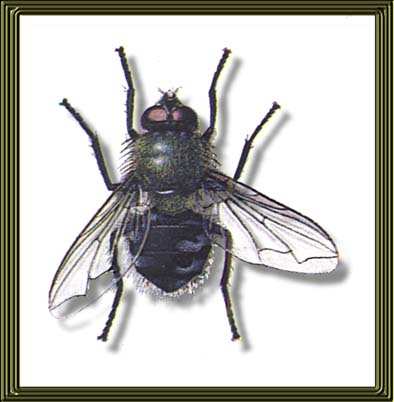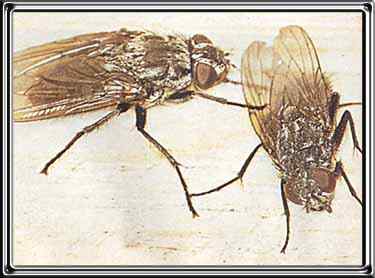
Pollenia rudis (Cluster Fly)
This is the fly that really gets up your nose in the middle of winter...there you are sat in your conservatory on a beautiful sunny day in early January..the sun is really quite warm under the glass...when to your horror you notice that there are numerous flies walking around the panes which make up the roof of the conservatory..."can't be" you say to your self, it's winter...! Well sorry folks but it can be and it's Cluster fly.
Biology:
These insects, sometimes called "attic flies", often become pests in homes. They usually appear in late fall or early winter and again on warm, sunny days in early spring. They buzz around the home and gather in large numbers at windows, often in rooms that are not regularly used. The cluster fly is a little larger than the common housefly and moves sluggishly.
It can be recognised by the short, golden coloured hairs on its thorax, the part of the body to which the legs and wings are attached. The larvae, or maggots, of cluster flies develop as parasites in the bodies of earthworms. The adult flies emerge in late summer and early autumn and seek protected places to spend the winter. In many cases, this is within the walls, attics and basements of homes.
A pair of Cluster Flies
Insect screens on windows offer no protection from the flies because they crawl in the home through small openings in the walls of the building. These same overwintering flies get into rooms during the winter and spring months entering through window pulley holes, around the baseboards and through other small openings in walls.Treatment:
As these type of flies tend to overwinter in roof-spaces, a good treatment is to release insecticidal smoke generators into the roof space. As the smoke settles a very thin film of insecticidal dust covers all the surfaces and when the fly cleans itself it ingests the insecticide and dies. Depending on the size of the roof-space depends on the number of generators used. Safety aspects should be observed;1. Ring the Fire Brigade...there will always be some passer-by who will see smoke coming out of your roof slates and will report the fact without asking you first...if a fire engine turns up for no reason you will be charged for the false call-out.
2. Always sit the smoke generators on a slate or a tin lid or something which is fire proof. We don't want to tell the fire brigade not to come and then end up having to call them anyway.
3. If you are using more than one generator, make sure that you ignite the ones furthest from the roof access first you don't want to breathe the smoke which is emitted...and you want to be able to see your way back to the roof access...REMEBER SAFETY AT ALL TIMES.As well as the smoke treatment, there other treatments which will help. Again these must be carried out with a total regard for safety...people tend to forget that when they use fly spray they should work their way out of the room, leaving that room for a least an hour to allow the fine droplets to sink to the floor. Experiments have shown that droplets will hang in the air for at least 45 minutes, leaving 15 minutes as an added safety factor. The same applies if you use dusting powders, which are very fine, like talcum powder, and will also hang in the air. You must remember that if spray kills flies, then it isn't going to be particularly healthy if you breathe it...!IF YOU HAVE LUNG COMPLAINTS OR PROBLEMS LIKE ASTHMA THEN DON'T HANDLE OR USE INSECTICIDES IN WHATEVER FORMS..!!
1. You can treat the glass windows in your conservatory or whatever, but no matter what anyone tells you there will be a slight smear effect, even with the cleanest of insecticides. What you can do is to spray the frames only which will sometimes be enough.
2. If you have sash windows...you know those windows which slide up and down and have pulley wheels at the top...well this is a favourite access point for the flies as they come out of the cavity wall. Treat these types of places with dusting powder...DON'T FORGET TO WEAR A MASK...and leave the treated room for at least an hour.
3. If your house has South facing external walls which are painted white, or are very light coloured, you will probably find that a lot of flies will bask on these walls as the light colour will reflect the heat nicely and insects need heat to be really active. You can treat these walls with an insecticide as well but realistically you would need a gallon sprayer to do the job. This would also cut down on the problems experienced in the house. BUT REMEMBER...if you spray insecticides externally not only will you kill the flies, but none target species as well.
4. If the problem is bad then you should really employ a pest control company. Here again you need to be careful, don't let them talk you into a contract for 94 visits a year...a little exaggeration...usually a problem site can be kept under control with 4 visits per annum and at the most 6.
5. If you are unsure then go back to the main fly page and email me...please ensure that you provide as much information as you can.
